Wearing a partial foot prosthetic is about more than just replacing lost function—it’s about ensuring comfort, stability, and long-term health. Many individuals with partial foot amputations struggle with posture and alignment issues, often without realizing it. Because the foot plays a crucial role in weight distribution and balance, even a small change in foot structure can impact the entire body.
Improper posture can lead to back pain, joint discomfort, and muscle fatigue. It can also make walking less efficient, causing unnecessary strain on the body. The good news is that with the right prosthetic, proper adjustments, and targeted exercises, individuals can maintain good posture and alignment, reducing discomfort and improving mobility.
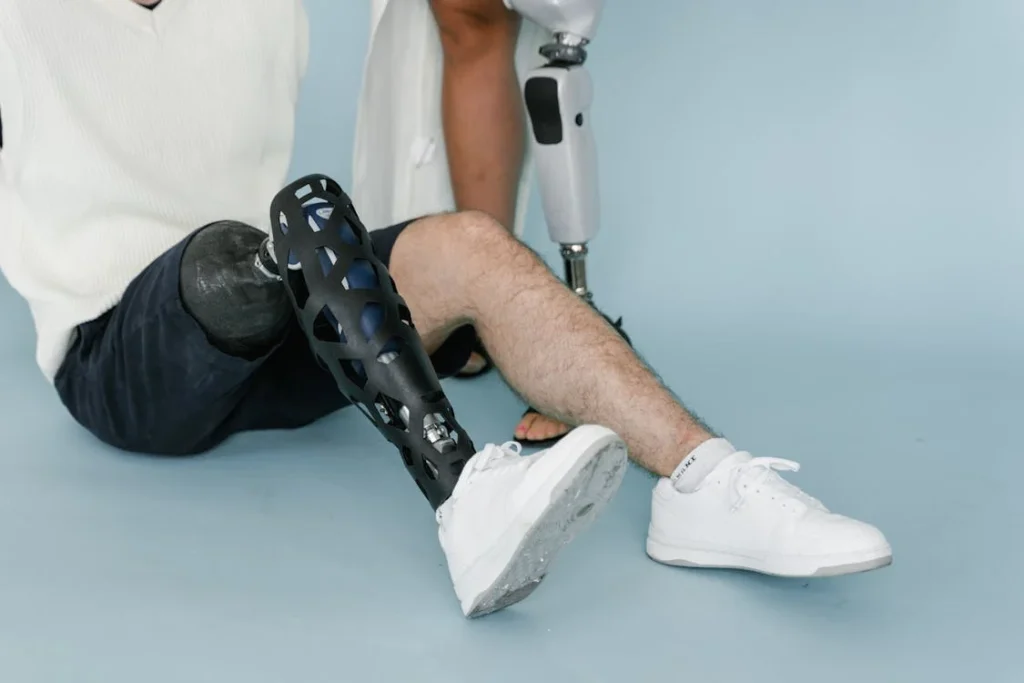
Understanding the Impact of Partial Foot Prosthetics on Posture
How Partial Foot Amputation Affects Balance
The human foot is designed to absorb shock, distribute weight evenly, and provide stability with every step. When part of the foot is missing, these natural functions are disrupted, which can affect the way the body aligns itself.
Many individuals unconsciously adjust their posture to compensate for the change, which can lead to uneven weight distribution, improper gait, and discomfort over time.
Without a full foot to provide push-off power, the body may shift weight toward the stronger side, creating an imbalance that extends up through the knees, hips, and spine.
This shift can cause unnatural movements, leading to pain and strain in other parts of the body. Over time, the muscles and joints begin to work in ways they were not designed for, which can result in fatigue, stiffness, and an increased risk of injury.
The Role of a Well-Fitted Prosthetic in Alignment
A properly fitted partial foot prosthetic helps restore balance by providing support in areas where natural foot function has been lost. The design of the prosthetic plays a critical role in ensuring that weight is distributed evenly, preventing excessive pressure on one side of the body.
The height, shape, and flexibility of the prosthetic all contribute to maintaining proper alignment while standing and walking.
If a prosthetic is too rigid or does not provide enough support, the user may struggle to place their foot flat on the ground, leading to an unnatural walking pattern. Similarly, if the prosthetic is too flexible, it may fail to provide the stability needed for smooth movement.
A well-designed prosthetic works with the body’s natural biomechanics, allowing for a fluid and comfortable gait while reducing the risk of strain on the joints and muscles.
Prosthetists carefully adjust the fit to ensure the prosthetic functions optimally. This process involves assessing walking patterns, weight distribution, and overall posture to make sure the body is properly aligned.
Many users find that even small modifications, such as slight adjustments in height or arch support, can make a significant difference in comfort and mobility.
The Connection Between Posture and Long-Term Health
Posture is not just about how a person stands; it affects overall health and movement efficiency. Poor posture caused by an improperly balanced prosthetic can lead to chronic pain in the lower back, hips, and knees.
When the body compensates for an imbalance, certain muscles work harder than they should, while others become weaker from underuse. Over time, this can lead to misalignment of the spine, joint pain, and difficulty maintaining mobility.
Proper posture with a partial foot prosthetic ensures that pressure is distributed evenly across both legs, reducing strain on the unaffected limb. It also promotes natural movement, allowing the body to function as efficiently as possible.
By maintaining good posture, individuals can move more freely, experience less discomfort, and reduce the risk of long-term joint issues.
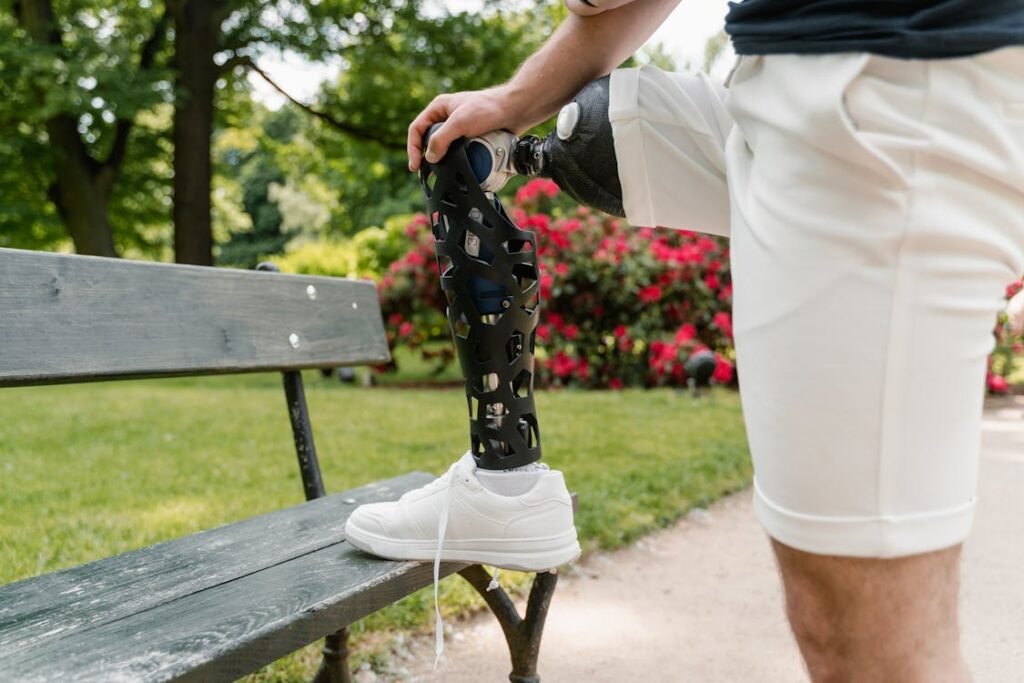
Strategies for Maintaining Proper Posture and Alignment
Strengthening Core and Lower Body Muscles
Maintaining proper posture with a partial foot prosthetic requires a strong core and lower body.
The core muscles—including the abdominals, obliques, and lower back—help stabilize the spine and keep the body upright.
When these muscles are weak, the body may lean forward, backward, or to the side to compensate, which can lead to discomfort and instability.
Physical therapy focuses on strengthening the core to improve balance and alignment. Exercises such as seated balance drills, controlled abdominal contractions, and standing posture training help reinforce stability.
Engaging these muscles while walking with a prosthetic ensures that weight is distributed properly, reducing the risk of strain on the hips and lower back.
The remaining leg also plays a significant role in maintaining posture. When one foot is partially amputated, the other leg often takes on more weight, which can lead to muscle imbalances.
Strengthening the quadriceps, hamstrings, and glutes helps ensure that both sides of the body are working together rather than one side compensating for the loss. Exercises such as step-ups, leg lifts, and resistance band training can improve strength and endurance, allowing for a more natural and efficient gait.
Adjusting Gait for Better Posture
Walking with a partial foot prosthetic requires slight modifications to ensure that the body remains properly aligned. Many individuals develop an uneven gait after amputation, unknowingly placing more weight on one side or taking shorter steps to avoid discomfort.
Over time, these compensations can lead to long-term posture problems.
Physical therapy helps users develop a more balanced gait by focusing on weight distribution and step length. Therapists guide individuals through controlled walking exercises, ensuring that each step is intentional and even.
By practicing weight shifts and foot placement, users learn how to move naturally without overcompensating on one side.
Prosthetic alignment also plays a role in maintaining a smooth gait. If the prosthetic is positioned too far forward or backward, it can throw off balance and make walking feel unnatural.
Regular follow-ups with a prosthetist ensure that the device is adjusted correctly for each user’s specific needs. Even minor changes, such as modifying the angle of the prosthetic or adjusting the support structure, can significantly improve walking comfort and posture.
Reducing Strain on the Spine and Joints
When posture is misaligned, the spine and joints absorb extra stress, leading to long-term discomfort and mobility issues. Many partial foot prosthetic users experience lower back pain because their body unconsciously shifts to compensate for the missing portion of the foot.
Addressing these issues early can prevent future complications and improve overall movement efficiency.
Stretching exercises help relieve tension in the muscles surrounding the spine, hips, and knees. Daily stretching routines focusing on the hamstrings, hip flexors, and lower back can improve flexibility and prevent stiffness.
In addition to stretching, posture correction techniques—such as standing tall with shoulders back and engaging the core—help reinforce proper alignment throughout the day.
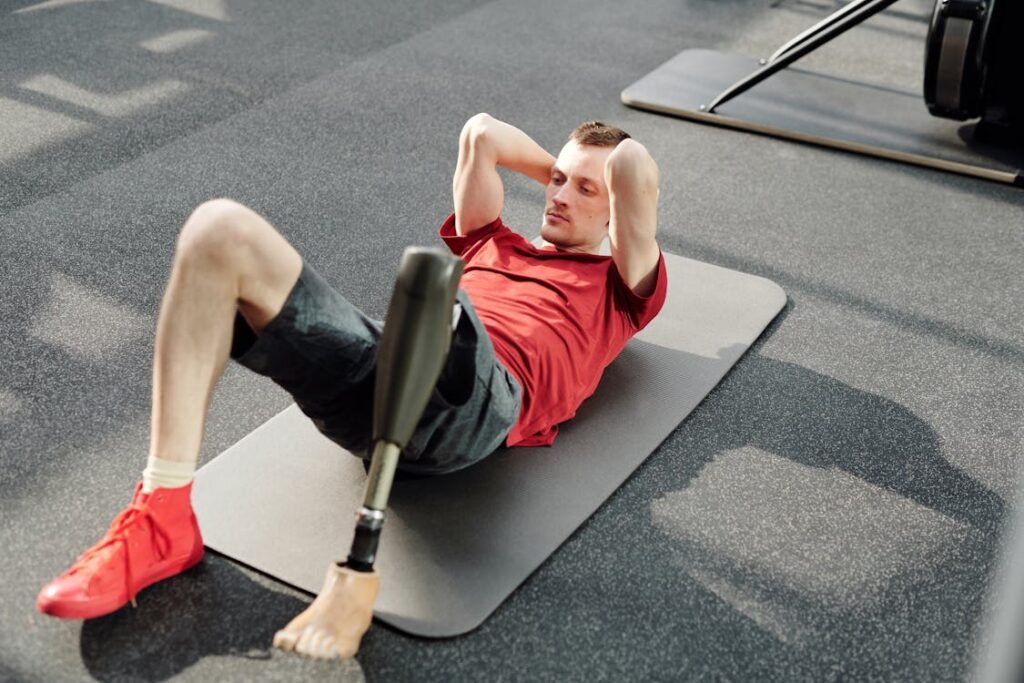
Daily Habits to Support Proper Posture with a Partial Foot Prosthetic
Maintaining Proper Footwear and Prosthetic Fit
Wearing the right footwear is just as important as having a well-fitted prosthetic when it comes to maintaining posture.
Footwear provides additional support, helping distribute weight evenly and reduce strain on the residual limb. Many partial foot prosthetic users find that wearing shoes with a firm sole and proper arch support enhances stability and comfort.
A poorly fitted prosthetic or worn-out footwear can cause an uneven gait, leading to misalignment of the spine and joints. Over time, this imbalance can result in chronic pain and difficulty walking long distances.
Regular checkups with a prosthetist ensure that the prosthetic continues to fit properly, adapting to any changes in body weight, muscle strength, or mobility needs. Adjustments to the height, shape, or flexibility of the prosthetic can significantly improve posture and walking efficiency.
Being Mindful of Standing and Sitting Posture
Maintaining good posture is not just about walking—it also applies to how a person sits and stands throughout the day.
Many partial foot prosthetic users develop habits such as leaning too much on one side, slouching, or locking their knee to compensate for balance issues. These small adjustments, while seemingly harmless, can contribute to muscle strain and spinal misalignment over time.
Standing posture should involve keeping the shoulders relaxed, the spine straight, and weight evenly distributed between both legs.
Engaging the core muscles while standing helps stabilize the body and prevents unnecessary pressure on the lower back. If prolonged standing causes discomfort, shifting weight between both legs periodically can reduce strain.
Sitting posture also plays a role in spinal health. Sitting for extended periods without proper support can cause the lower back to curve unnaturally, leading to discomfort.
Using a chair with good lumbar support and keeping both feet flat on the ground helps maintain proper alignment. For individuals who spend long hours sitting, taking breaks to stand, stretch, and move around can prevent stiffness and improve circulation.
Practicing Postural Awareness in Daily Activities
Posture is something that needs to be actively maintained throughout the day, especially when performing daily tasks.
Many prosthetic users unintentionally develop postural habits that increase strain on the body, such as leaning too far forward while walking, favoring one side when reaching for objects, or adjusting weight distribution to reduce discomfort.
One of the best ways to improve posture is through mindful movement. Paying attention to body alignment while walking, climbing stairs, or bending down can prevent unnecessary strain on the spine and joints.
Checking in with posture throughout the day—whether while standing in line, carrying groceries, or getting in and out of a vehicle—can help reinforce healthy movement patterns.
Regular physical therapy sessions also help reinforce postural awareness. Therapists guide individuals through targeted exercises that strengthen muscles, improve coordination, and train the body to maintain proper alignment naturally.
Over time, these movements become second nature, reducing the likelihood of pain or posture-related issues.
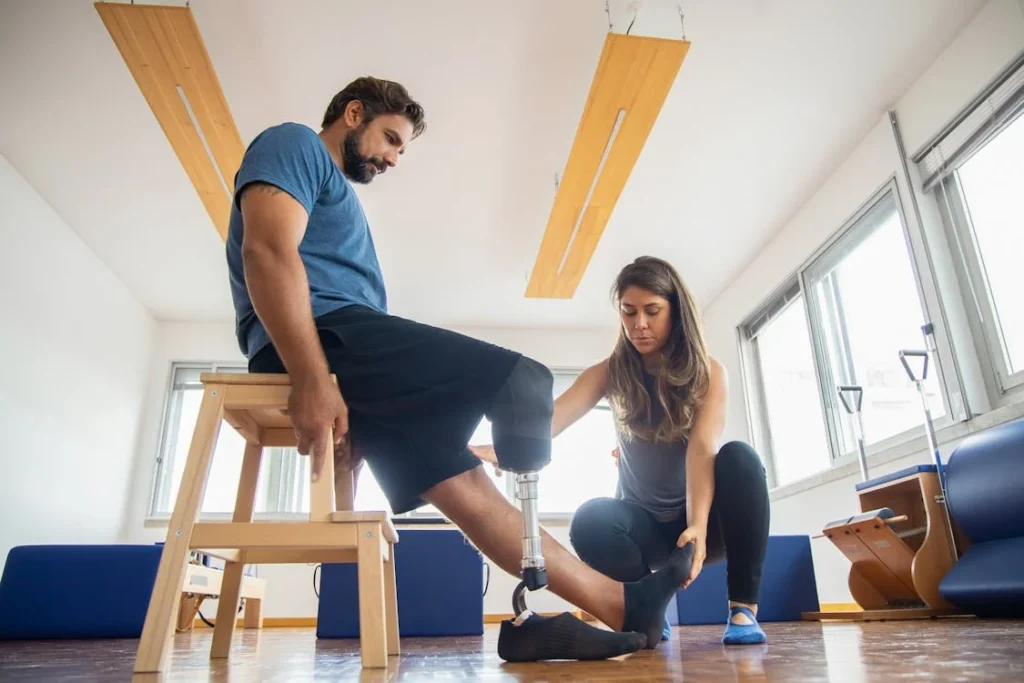
The Role of Physical Therapy in Maintaining Posture and Alignment
Strengthening Muscles to Support Proper Alignment
Physical therapy plays a crucial role in helping individuals with partial foot prosthetics maintain proper posture. Since the body’s natural weight distribution is altered after amputation, certain muscles need to work harder to compensate.
Strengthening these muscles prevents imbalances that could lead to pain and discomfort.
Therapists focus on building strength in key areas such as the core, lower back, and leg muscles. Core exercises help stabilize the spine, preventing unnecessary leaning or arching while walking.
Strengthening the hip and thigh muscles ensures that weight is distributed evenly, reducing strain on the unaffected limb. Over time, this increased strength allows for smoother, more efficient movement with the prosthetic.
Balance training is also an essential part of physical therapy. Since posture depends on the body’s ability to stay stable, exercises that improve coordination and weight shifting are introduced.
Standing on one leg, controlled weight transfers, and dynamic stability exercises help reinforce proper alignment and improve confidence while moving.
Correcting Postural Habits Through Guided Training
Many individuals unknowingly develop poor postural habits after a partial foot amputation. These habits—such as favoring one side while walking or keeping the knee locked while standing—can lead to long-term discomfort.
Physical therapy helps identify these habits and provides corrective strategies to restore natural posture.
Gait training is a key component of posture correction. Therapists analyze walking patterns and make adjustments to ensure a smooth and balanced gait.
They may guide individuals through slow-motion walking drills, focusing on even step distribution and proper foot placement. Over time, these adjustments become ingrained, helping individuals walk more naturally without overcompensating.
In addition to walking exercises, postural retraining techniques help reinforce proper spinal alignment. Therapists use visual and physical cues to teach individuals how to position their shoulders, hips, and head correctly.
Practicing these corrections in a controlled setting helps reinforce good habits that can be applied in everyday activities.
Using Assistive Devices to Improve Stability
For some individuals, additional support is needed to maintain proper posture and alignment. Assistive devices such as shoe inserts, orthotic supports, and walking aids can enhance stability and reduce stress on the residual limb.
These tools help distribute weight more evenly, making it easier to maintain balance and posture throughout the day.
Prosthetists work closely with therapists to determine if modifications to the prosthetic are needed. A minor adjustment in height, cushioning, or flexibility can significantly impact comfort and walking efficiency.
Ensuring that the prosthetic is aligned correctly with the body’s natural movement reduces unnecessary strain and allows for a more natural gait.
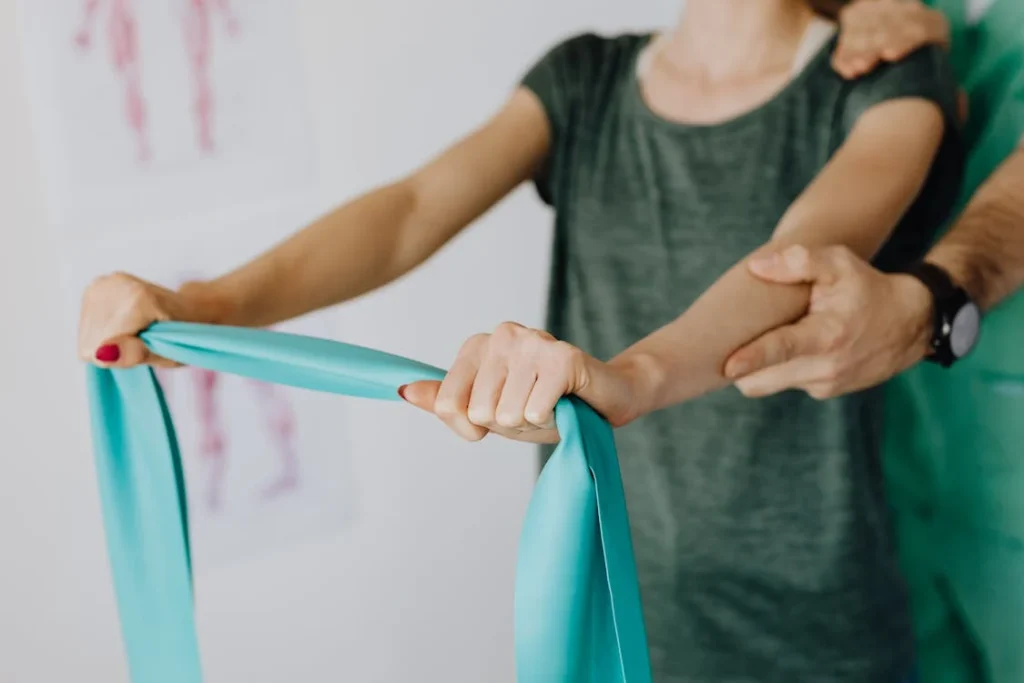
Preventing Long-Term Posture-Related Issues
Reducing the Risk of Back and Joint Pain
One of the biggest concerns for partial foot prosthetic users is the long-term impact of poor posture on the spine and joints. When weight is not distributed evenly, the body compensates by shifting pressure to other areas, which can lead to chronic pain in the lower back, hips, and knees.
Over time, these imbalances can result in muscle fatigue, joint degeneration, and reduced mobility.
Maintaining proper posture helps prevent these issues by keeping the spine aligned and reducing stress on weight-bearing joints.
Walking with an even stride, engaging core muscles, and ensuring both legs share the load equally minimizes the risk of developing discomfort over time.
Regular physical therapy sessions help reinforce these habits, ensuring that individuals continue to move efficiently without placing excess strain on their bodies.
Stretching is also an important factor in preventing pain and stiffness. When posture is misaligned, certain muscles become tight while others weaken.
Daily stretching routines that target the lower back, hamstrings, and hip flexors can help improve flexibility, allowing the body to maintain better posture naturally.
Combining strength training with stretching ensures that the muscles remain balanced and capable of supporting proper movement patterns.
Adapting to Changes in Mobility Over Time
As the body adapts to a partial foot prosthetic, changes in muscle tone, gait, and overall mobility can occur. Individuals may experience shifts in balance, adjustments in walking patterns, or even changes in how the prosthetic fits due to weight fluctuations.
These factors can affect posture, making it essential to reassess movement habits regularly.
Routine checkups with a prosthetist help ensure that the prosthetic remains properly fitted and aligned. Small modifications, such as adjusting the arch support or altering the prosthetic’s angle, can make a significant difference in posture and walking efficiency.
If discomfort or strain develops, consulting with a physical therapist can help identify any necessary adjustments in movement techniques or strengthening exercises.
Maintaining an active lifestyle also plays a crucial role in long-term mobility. Engaging in low-impact activities such as swimming, yoga, or cycling helps keep the body flexible and strong.
Staying active prevents muscle atrophy and keeps joints functioning properly, reducing the likelihood of posture-related discomfort.
The Psychological Impact of Good Posture
Posture is not just about physical health—it also influences confidence and overall well-being. When standing tall with a properly aligned posture, individuals often feel more self-assured and comfortable in their movement.
Poor posture, on the other hand, can create a sense of instability and self-consciousness, leading to hesitation in daily activities.
By focusing on posture and alignment, individuals can regain confidence in their ability to move freely and independently. Physical therapy provides the tools needed to build this confidence, ensuring that each step feels controlled and natural.
Over time, maintaining good posture becomes second nature, allowing users to navigate their environment with ease and assurance.
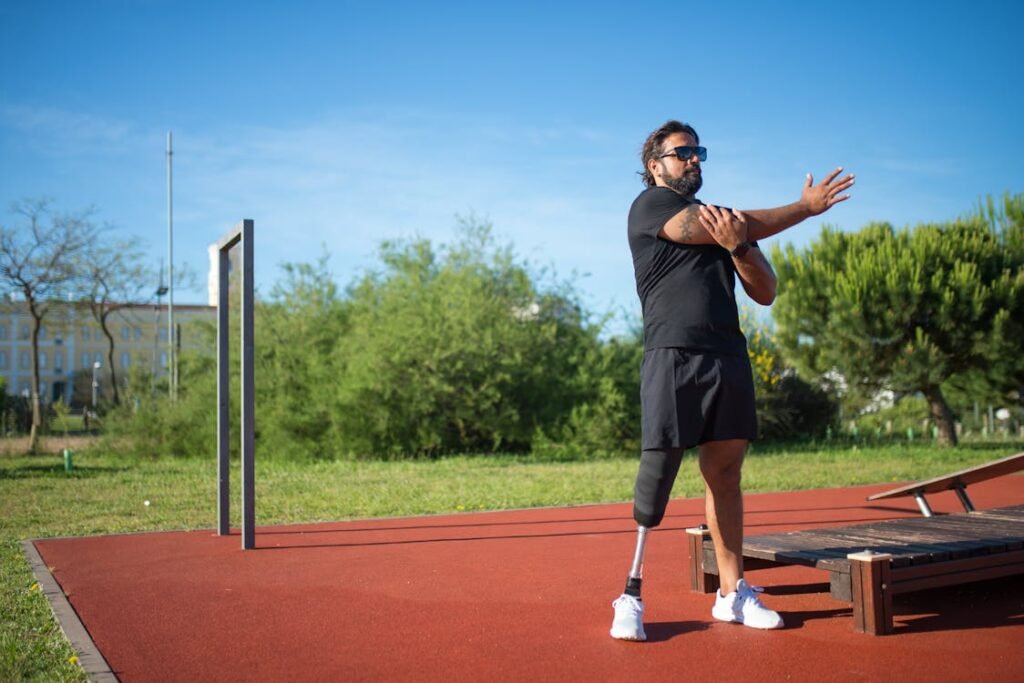
The Role of Lifestyle Choices in Maintaining Posture and Alignment
Staying Physically Active to Support Postural Health
Regular movement is essential for maintaining proper posture, especially when using a partial foot prosthetic. A sedentary lifestyle can weaken the muscles that support balance and alignment, making it harder to stand and walk correctly.
Engaging in daily physical activity helps strengthen the core, legs, and back, all of which contribute to maintaining good posture.
Low-impact activities such as swimming, walking, and yoga are excellent choices for keeping muscles active without placing excessive strain on the body.
Swimming, in particular, is beneficial because the water provides resistance while reducing the impact on joints, allowing users to build strength in a controlled environment.
Yoga focuses on flexibility and core stability, both of which improve balance and alignment.
Walking remains one of the most important forms of exercise for prosthetic users. Practicing mindful walking—paying attention to foot placement, step length, and body posture—reinforces healthy movement habits.
Using a mirror or recording oneself while walking can help identify any posture issues that need correction.
Maintaining a Healthy Weight to Reduce Strain
Weight management plays a crucial role in posture and alignment. Carrying excess weight can put additional pressure on the spine, hips, and residual limb, leading to an increased risk of joint pain and postural imbalances.
Maintaining a healthy weight ensures that movement remains efficient and comfortable.
A balanced diet that includes lean proteins, healthy fats, and nutrient-rich vegetables supports muscle strength and joint health.
Proper hydration is also essential, as dehydration can contribute to muscle tightness and fatigue, affecting posture and movement.
For individuals who experience weight fluctuations, regular prosthetic adjustments may be necessary. Changes in body composition can affect how the prosthetic fits, potentially altering gait and alignment.
A properly fitted prosthetic reduces unnecessary strain on the body, allowing for smoother movement and better posture.
Getting Enough Rest and Recovery
Muscle fatigue can contribute to poor posture, especially if the body is not given enough time to rest and recover. A lack of sleep or prolonged physical exertion can cause the body to compensate by adopting poor movement habits.
Over time, this can lead to muscle imbalances and discomfort.
Quality sleep is essential for muscle repair and overall well-being. Sleeping in a supportive position with a properly aligned spine prevents unnecessary stress on the back and joints.
Using a firm mattress and a pillow that supports the neck can help maintain good posture even while resting.
Taking regular breaks throughout the day to stretch and adjust posture also prevents stiffness and fatigue. If standing for long periods, shifting weight between both legs and engaging core muscles can help maintain balance.
For those who sit frequently, adjusting chair height and lumbar support ensures proper spinal alignment, reducing pressure on the lower back.
Conclusion
Maintaining proper posture and alignment with a partial foot prosthetic is essential for comfort, mobility, and long-term health. By focusing on strengthening core and lower body muscles, ensuring a well-fitted prosthetic, and practicing mindful movement, individuals can reduce strain on their joints and move more efficiently. Regular physical therapy, stretching, and daily activity help reinforce good posture, preventing discomfort and improving overall stability.
Lifestyle choices, including staying active, maintaining a healthy weight, and getting proper rest, also play a key role in posture management. Small adjustments, such as wearing supportive footwear and using assistive tools when needed, can make a significant difference in everyday movement. Over time, good posture becomes second nature, allowing prosthetic users to walk with confidence and ease.
At Robobionics, we are committed to helping individuals regain their independence with high-quality prosthetic solutions and expert guidance. If you or a loved one is adapting to a partial foot prosthetic and needs support with posture and alignment, contact us today to learn how we can help improve your mobility and quality of life.



